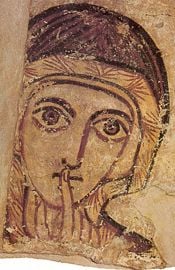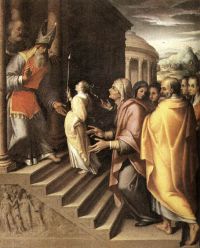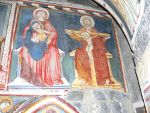Difference between revisions of "Saint Anne" - New World Encyclopedia
m (→Husbands) |
|||
| Line 57: | Line 57: | ||
==Husbands== | ==Husbands== | ||
| + | [[Image=John-of-Damascus_01.jpg|thumb|200px| St. John Dmascus]] | ||
Varying theologians have believed either that Joachim was Anne's only husband, or that she was married three times. Ancient belief, attested to by a sermon of [[John of Damascus|St John Damascene]], was that Anne married once. In late medieval times, legend held that Anne was married three times, first to Joachim, then to [[Clopas]], and finally to a man named Solomas, and that each marriage produced one daughter: Mary, mother of Jesus, [[Mary of Clopas]], and [[Salome (disciple)|Mary Salomae]], respectively.<ref>Golden Legend II.131</ref> | Varying theologians have believed either that Joachim was Anne's only husband, or that she was married three times. Ancient belief, attested to by a sermon of [[John of Damascus|St John Damascene]], was that Anne married once. In late medieval times, legend held that Anne was married three times, first to Joachim, then to [[Clopas]], and finally to a man named Solomas, and that each marriage produced one daughter: Mary, mother of Jesus, [[Mary of Clopas]], and [[Salome (disciple)|Mary Salomae]], respectively.<ref>Golden Legend II.131</ref> | ||
Revision as of 17:39, 24 May 2008
| Saint Anne | |
|---|---|
St. Anne, fresco from Faras, 7th century | |
| Mother of the Blessed Virgin Mary | |
| Venerated in | Roman Catholic Church; Orthodox Church; Anglicanism; Eastern Catholic Churches |
| Feast | July 26 |
| Attributes | Book, door, with Mary, Jesus, or Joachim |
| Patronage | carpenters; childless people; equestrians; grandparents; homemakers/housewives; lace makers; lost articles; miners; mothers; moving house; old-clothes dealers; poverty; pregnancy; seamstresses; stablemen; sterility; turners. |
- This article is about the mother of the Virgin Mary. For other uses of the term, see Saint Anne (disambiguation).
According to Christian tradition, Saint Anne (also Ann or Anna) of David's house and line, was the mother of the Virgin Mary. Her name, Anne, is a Greek rendering of a Hebrew name, Hannah meaning "Grace". Mary's mother is not named in the canonical Gospels. According to the apocryphal Gospel of James, Anne and her husband Joachim, after years of childlessness, were visited by an angel who told them that they would conceive a child. Anne promised to dedicate the child to God's service. Joachim and Anne are believed to have given Mary to the service of the Second Temple when the girl was three years old.[1] Anne is a patron saint of Quebec and Brittany, and patroness of women in labor and miners.
Sources of Anne's story
Anne is not mentioned in the New Testament at all. All information on the parents of Mary, the mother of Jesus, Joachim and Anne, is found in only apocryphal literature, the Gospel of the Nativity of Mary, the Gospel of Pseudo-Matthew and the Protoevangelium of James. The earliest is the Protevangelium of James and is dated to about 150, the other two seemed to have based their writings at least in part on this document.
The Protoevangelium was venerated by the Greeks, Syrians, Copts, and Arabs. Portions of it were read on the feasts of Mary. Only after Jacobus de Voragine incorporated it into his Golden Legend in the thirteenth century did the church fathers accept it. After which Anne became very popular in the Latin church as well.
Saint Anne's story
In the sources, Anne's story (or Hannah) is told that she and Joachim were married many years in Nazareth and were childless. When Joachim went to offer sacrifices in the temple he was rejected because he was unworthy as he had no offspring. Joachim was brokenhearted and went to the mountains to take up his cause with God. Anna worried about the absence of her husband, and learning of his mountain prayer, joined him in crying out to God. She begged Him to take away her sterility and promised to dedicate her child to His service. It seems that God answered their prayers when an angel appeared to Anna or Hannah, saying: "Hannah, the Lord has looked upon thy tears; thou shalt conceive and give birth and the fruit of thy womb shall be blessed by all the world." It is reported that the angel also made the same promise to Joachim. Anna gave birth to a daughter, Mary or Miriam.
When Mary was three years old, her parents brought her to the Temple at Jerusalem, in fulfillment of their promise, where they left her to be brought up. In 1585, Pope Sixtus V included this event in the Western church calendar for the liturgical feast of the Presentation of the Virgin Mary (November 21). Originally observed early in the East, probably at Jerusalem in 543, the Western observance was first recorded in England in the 11th century. [2]
Similar story
The story bears a superficial similarity to that of the conception and birth of Samuel, whose mother Hannah had also been childless. The name of Mary's mother was written, Hannah, with the similarity of events brings doubt to the story of Mary's birth and her parents story.
Christian Church recognition
Although Anne's cult receives little attention in the Western church prior to the late 12th century,[3] dedications to Anne in the Eastern church occur as early as the 4th century, Justinian I (died 565) dedicated a church to Anne. A canon in the Greek Office of Saint Anne was composed by Saint Theophanes, and later by Anatolius of Byzantium (died 458).[4]
In the Eastern Orthodox tradition, Anne is ascribed the title Forbear of God, and both the Birth of Mary and the Dedication of Mary to the Temple are celebrated as two of the Twelve Great Feasts.
The eastern feast is on July 25, perhaps this date is the dedication day of Anne's first church in Constantinople or in recognition of the day recognized as the arrival of her supposed relics into Constantinople (710) at the church of Saint Sophia (kept until 1333). This is found in the Calendar of Constantinople (first half of the eighth century), the oldest liturgical document of the Greek Church. There is also a collective feast of Saint Joachim and Saint Anne on September 9th.
Saint Anne was not venerated much by the Latin Church before the thirteenth century, except, in the south of France. The Dominican priest, Jacobus de Voragine printed the story of Anne in his Golden Legend in 1298, after the Crusaders brought the legend from the Orient to Europe. The Franciscans, Dominicans, Augustinians, and Carmelites supported its observation. In south France, a Feast of Saint Anne was celebrated in the fourteenth century, on November 21, 1378 by Pope Urban VI, and at the king's request was extended to England. From this time it spread to all of the Western church. The universal Latin Church accepted it in 1584 when Pope Gregory XIII prescribed it.
Her Latin feast, July 26, was established under the influence of the Golden Legend at Douai in 1291. Supposedly, a foot of Saint Anne is buried and venerated there.
Her body were supposed to have been brought to Apt, southern France, by Saint Lazarus, the friend of Christ, was then was hidden by Saint Auspicius (died 398), and found again during the reign of Charlemagne. Some claimed that her head was kept at Mainz, Germany up to 1510 from where it was stolen and then placed in Düren in Rheinland.
Saint Anne is the primary patron of the province of Quebec, Canada, celebrated at the shrine of Saint Anne de Beaupré.[5]
Husbands
thumb|200px| St. John Dmascus Varying theologians have believed either that Joachim was Anne's only husband, or that she was married three times. Ancient belief, attested to by a sermon of St John Damascene, was that Anne married once. In late medieval times, legend held that Anne was married three times, first to Joachim, then to Clopas, and finally to a man named Solomas, and that each marriage produced one daughter: Mary, mother of Jesus, Mary of Clopas, and Mary Salomae, respectively.[6]
Virgin birth question
Similarly, in the 4th century, and then much later in the 15th century, a belief arose that Mary was born of Anne by virgin birth. [7] Those believers included the 16th century mystic Valentine Weigel who claimed Anne conceived Mary by the power of the Holy spirit. This belief was also condemned as an error by the Catholic Church in 1677. Instead, the Church teaches that Mary was conceived in the normal fashion, but that she was miraculously preserved from original sin in order to make her fit to bear Christ. The conception of Mary free from original sin is termed the Immaculate Conception—which is frequently confused with the Virgin Birth or Incarnation of Christ.
Iconography
The iconographic subject of Joachim and Anne The Meeting at the Golden Gate fit both views of Mary's conception, and was a regular component of artistic cycles of the "Life of the Virgin." The couple meet at the "Golden Gate" of Jerusalem and embrace. They are aware of Anne's pregnancy, of which they have been separately informed by an archangel. For those believing in the virgin birth of Mary, this moment stood for her conception, and the feast was celebrated on the same day as the Immaculate Conception. The Birth of Mary, the Presentation of Mary and the Marriage of the Virgin were usual components of cycles of the Life of the Virgin in which Anne is normally shown.
In Western iconography, Anne may be recognized by her depiction in red robe and green mantle, often holding a book. Images may also be found depicting Anne holding a small Mary who in turn holds an infant Christ. Such trinitarian representations mirror similar depictions of the Trinity, and were sometimes produced as pairs.[8]
Anne's picture was found more recently in the church of Santa Maria Antiqua in Rome, (eighth century) whose origin seems Byzantine.
Presence in the life of Mary and Jesus
Anne is never shown as present at the Nativity of Christ, but is frequently shown with the infant Christ in various subjects. She is normally shown as present at the Presentation of Jesus at the Temple and the Circumcision of Christ. There was a tradition that she went (separately) to Egypt and rejoined the Holy Family after their Flight to Egypt. Anne is not seen with the adult Christ, so was regarded as having died during the youth of Jesus.[9] Anne is also shown as the matriarch of the Holy Kinship, the extended family of Jesus, a popular subject in late medieval Germany.
Patronage
Saint Anne is patron of the following places: Canada; France; Brittany; Quebec; Adjuntas, Puerto Rico; Detroit, Michigan; Norwich, Connecticut; Santa Ana Pueblo; Seama, New Mexico; Taos, New Mexico; Marsaskala; and the Philippines.
Notes
- ↑ Jacobus de Voragine’s Golden Legend, Volume II, Chapter 131.
- ↑ Dedication of Mary at the Temple saints.sqpn.com Retrieved May 22, 2008.
- ↑ Virginia Nixon, Mary's Mother: Saint Anne in Late Medieval Europe p. 12-14.
- ↑ Procopius' Buildings, Volume I, Chapters 11-12.
- ↑ Catholic Encyclopedia 1913 www.newadvent.org Retrieved May 21, 2008.
- ↑ Golden Legend II.131
- ↑ Catholic Encyclopedia 1913 www.newadvent.org Retrieved May 21, 2008.
- ↑ Catholic Herald article www.catholicherald.com,"Vierge Ouvrante" (Open body of the Virgin) statue images.google.co.uk Retrieved May 21, 2008.
- ↑ Some writers surmised her age at death, as part of a general family chronology, but no generally accepted tradition developed on this point, even during the Middle Ages.
ReferencesISBN links support NWE through referral fees
- De Voragine, Jacobus; William Granger Ryan, trans. The Golden Legend II, Princeton University Press, 1993. ISBN 978-0691031781
- Kreitzer, Beth. Mary's Mother: Saint Anne in Late Medieval Europe. Book Review, an article from: Church History [HTML] (Digital), December 1, 2005. Thomson Gale publ. vol. 74 Issue: 4 p. 842.
- Nixon, Virginia. Mary's Mother: Saint Anne in Late Medieval Europe, Pennsylvania: Pennsylvania State University Press, 2004. ISBN 978-0271024660
- Procopius. H. B. Dewing and Glanville Downey, trans. On Buildings: General Index, Loeb Classical Library, No. 343, Volume I, 1940. ISBN 978-0674993785 ASIN B000TDTH9
- The Protoevangelium of James saints.sqpn.com Retrieved May 21, 2008.
- This article incorporates content from the 1917 Catholic Encyclopedia, a publication in the public domain.
External links
All retrieved May 21, 2008.
- Catholic Encyclopedia 1913 www.newadvent.org
- Eternal Word Television Network www.ewtn.com
- Patron Saints Index www.catholic-forum.com
- Template:1913C.E.
- Catholic Herald article www.catholicherald.com
- Brief American Catholic article on "Sts. Joachim and Ann" www.americancatholic.org
Credits
New World Encyclopedia writers and editors rewrote and completed the Wikipedia article in accordance with New World Encyclopedia standards. This article abides by terms of the Creative Commons CC-by-sa 3.0 License (CC-by-sa), which may be used and disseminated with proper attribution. Credit is due under the terms of this license that can reference both the New World Encyclopedia contributors and the selfless volunteer contributors of the Wikimedia Foundation. To cite this article click here for a list of acceptable citing formats.The history of earlier contributions by wikipedians is accessible to researchers here:
The history of this article since it was imported to New World Encyclopedia:
Note: Some restrictions may apply to use of individual images which are separately licensed.


